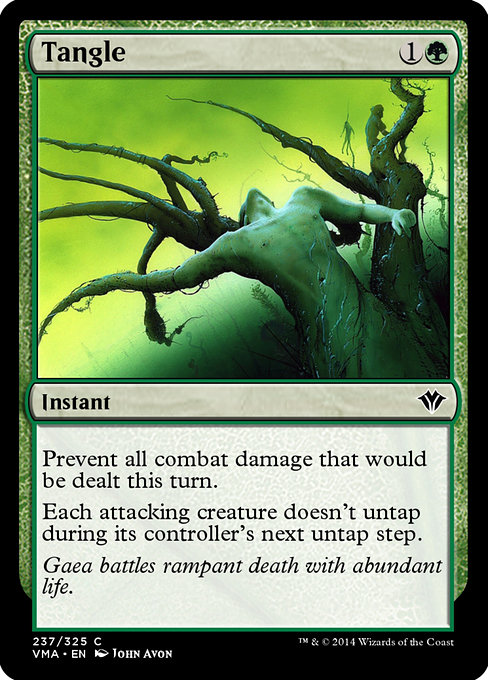
Image courtesy of Scryfall.com
Art Reprint Frequency in MTG: A Data-Driven Look at Tangle
When you shuffle through the heritage ofMTG art, you inevitably bump into the same brushstrokes reappearing across different sets. For green-oriented instants like Tangle, the question isn’t just “does it work in gameplay?” but also “how often does that luminous John Avon artwork get revisited in print?” This data-driven examination uses a concrete example—the Vintage Masters print of Tangle—to explore what reprint frequency really means in practice, why publishers lean on familiar art, and what it signals for collectors and players alike 🧙♂️🔥💎.
Card snapshot: what Tangle brings to the table
- Name: Tangle
- Mana cost: {1}{G}
- Type: Instant
- Colors: Green
- Rarity: Common
- Set: Vintage Masters (VMA)
- Release date of this print: 2014-06-16
- Artist: John Avon
- Text: Prevent all combat damage that would be dealt this turn. Each attacking creature doesn't untap during its controller's next untap step.
- Flavor text: “Gaea battles rampant death with abundant life.”
Why art matters in reprint frequency
Magic cards are more than numbers on a screen; they’re artifacts of storytelling and design. A single illustration can create a shared memory among players, lore-seekers, and collectors. When a Masters set like Vintage Masters (a reprint-centric line) surfaces, it’s not just about the card’s power—it's about preserving a moment in art history. Tangle’s artwork by John Avon, a veteran of lush forested scenes, embodies that idea: the image anchors a card that’s both strategic in play and nostalgic in its visuals. The question data teams chase is whether that same painting resurfaces in later printings, how often, and under what constraints (foil vs. non-foil, border treatments, alternate frames, etc.).
“Art is the oldest form of metagaming: you curate what the world sees while you plan what to do next.” 🎨⚔️
Data-driven picture: how we assess reprint frequency
To quantify reprint frequency, we look at a few reliable signals from card databases such as Scryfall and Gatherer:
- Reprint flag: Whether the card entry explicitly marks the card as a reprint in the set’s context.
- Set lineage: Whether the card appears in Masters or Special Sets designed specifically to reissue older cards.
- Artwork continuity: Whether the same artwork (crediting the same artist) is used across prints, or if the art is swapped for a different painting.
- Print runs: Availability in foil vs. non-foil versions and border styles, which often accompany reprint cycles.
- Collector signals: Rarity, market price trends, and EDH/Commander relevance, which can hint at long-tail demand for familiar art.
In Tangle’s case, the Vintage Masters entry confirms a dedicated reprint in a Masters line, with this particular card sharing the green prowess and a classic Avon forest mood. This is a textbook example of how a single art piece travels through time: the card’s mechanics (a green instant with prevention of combat damage and a forcing untap step drawback for attacking creatures) stay stable, while the artwork travels in a loop through reprint batches. The net effect for data nerds is a small but telling data point: a common card with a well-loved artist on a reprint path in a set explicitly designed to reissue older magic. 🧙♂️🎲
The Tangle print within Vintage Masters: what the numbers whisper
The data sheet for this print shows:
- Set type: Masters
- Rarity: Common
- Print status: Reprint
- Art: John Avon (consistent across this and possibly other reprints)
- Market signal: Low price point in the tix market, typical for commons, but with evergreen appeal due to art and green playstyle.
What does that imply for future reprints? In broad terms, green instants with strong control or tempo elements tend to land in Masters sets when Wizards wants to showcase classic tools of the color, typically with a visually appealing illustration. If a future reprint were to occur, data would likely show either a continuation of Avon’s forested motif or a deliberate swap to a fresh, iconic landscape painting. Either way, the thread remains: Masters sets leverage recognizable art to spark nostalgia while delivering playable, budget-friendly options for players to deploy in Commander and late-game decks. 🧚♀️💎
Why this matters for players and collectors
For players, Tangle represents a reliable, green-speed control option at a modest mana cost, best used in decks that can weather a tempo storm and then swing back with renewed pressure. The card’s ability to prevent combat damage this turn can buy critical turns in mid-game skirmishes, especially against aggressive boards. For collectors, the Vintage Masters print is a reminder of the power of reprints to refresh the pool of playable cards while preserving beloved artwork. The fact that this artwork’s reprint is part of a highly curated Masters set adds an extra layer of collectability—harder to find in foil, perhaps, but with the same visual resonance that makes Avon’s forests sing. 🧙♂️🔥
As you consider your own MTG journey, you might be balancing playtime with a hunt for art that speaks to you. If you’re thinking about a little cross-promotion while you plan your next purchase, there’s a neat companion to your desk space—an item designed to keep your gaming surface as stylish as your playstyle. The link below points you toward a product that blends utility with a touch of fandom flair. It’s a small nod to how the hobby seeps into everyday life, one tactile, well-crafted piece at a time.